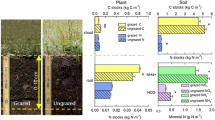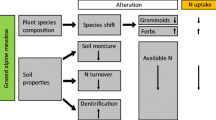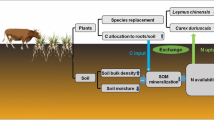Abstract
Background and aims
Grazing drives carbon (C) and nitrogen (N) dynamics of grasslands through livestock trampling, defoliation, and excretion. Still, the responses of N uptake by plant species and simultaneous C allocation into the soil to grazing intensity remain unclear.
Methods
In-situ 15NH4+ / 15NO3− and 13C-CO2 labeling experiment was conducted in Inner Mongolia grasslands under 5 years of grazing with no, light (4 sheep 1.33 ha−1) and heavy (12 sheep 1.33 ha−1) intensity to reveal the contribution of plant-derived C into the soil and the fate of N on day one and three after 13C-labeling. Experiment had a completely randomized design (n = 3), and every plot included Leymus chinensis, Carex korshinskyi, Cleistogenes squarrosa, and Stipa grandis.
Results
Grazing increased plants’ total N uptake compared to control (no grazing); higher NO3− uptake was found compared to NH4+ (aboveground: 0.40–20.78 vs. 0.32–6.58 µg N m−2; belowground: 0.04–9.92 vs. 0.01–0.49 µg N m−2), irrespective of grazing intensity. C. korshinskyi showed the highest N uptake (3–21 µg N m−2) under the three grazing intensities. 13C-CO2 assimilation was the lowest under heavy grazing (aboveground: 1.06–10.67 mg C m−2; belowground: 0.25–1.53 mg C m−2) regardless of plant species. 13C-CO2 assimilation by L. chinensis and C. squarrosa decreased 3–5 times with grazing intensity. Grazing increased 13C-SOC irrespective to soil depth compared to no grazing.
Conclusions
Grazing patterns affected the plants’ total assimilation C capacity and N uptake and the response varies among plant species, as well as the allocation of plant-C transfer into the soil.







Similar content being viewed by others
Data Availability
All data that support the findings of this study can be found in the article and/or supplementary materials.
References
Bagchi S, Ritchie ME (2010) Introduced grazers can restrict potential soil carbon sequestration through impacts on plant community composition. Ecol Lett 13:959–968. https://doi.org/10.1111/j.1461-0248.2010.01486.x
Bai YF, Cotrufo MF (2022) Grassland soil carbon sequestration: current understanding, challenges, and solutions. Science 377:603–608. https://doi.org/10.1126/science.abo2380
Canarini A, Kaiser C, Merchant A, Richter A, Wanek W (2019) Root exudation of primary metabolites: mechanisms and their roles in plant responses to environmental stimuli. Front Plant Sci 10:157. https://doi.org/10.3389/fpls.2019.00157
Chen D, Xing W, Lan Z, Saleem M, Wu Y, Hu S, Bai Y (2019) Direct and indirect effects of nitrogen enrichment on soil organisms and carbon and nitrogen mineralization in a semi-arid grassland. Funct Ecol 33:175–187. https://doi.org/10.1111/1365-2435.13226
Crawford NM, Glass ADM (1998) Molecular and physiological aspects of nitrate uptake in plants. Trends Plant Sci 3:389–395. https://doi.org/10.1016/S1360-1385(98)01311-9
Cui X, Wang Y, Niu H, Wu J, Wang S, Schnug E, Rogasik J, Fleckenstein J, Tang Y (2005) Effect of long-term grazing on soil organic carbon content in semiarid steppes in Inner Mongolia. Ecol Res 20:519–527. https://doi.org/10.1007/s11284-005-0063-8
Davidson KE, Fowler MS, Skov MW, Doerr SH, Beaumont N, Griffin JN (2017) Livestock grazing alters multiple ecosystem properties and services in salt marshes: a meta-analysis. J Appl Ecol 54:1395–1405. https://doi.org/10.1111/1365-2664.12892
Derner JD, Boutton TW, Briske DD (2006) Grazing and ecosystem carbon storage in the North American Great Plains. Plant Soil 280:77–90. https://doi.org/10.1007/s11104-005-2554-3
Ding K, Zhong L, Xin XP, Xu ZH, Kang XM, Liu WJ, Rui YC, Jiang LL, Tang L, Wang YF (2015) Effect of grazing on the abundance of functional genes associated with N cycling in three types of grassland in Inner Mongolia. J Soil Sediment 15:683–693. https://doi.org/10.1007/s11368-014-1016-z
Dlamini P, Chivenge P, Chaplot V (2016) Overgrazing decreases soil organic carbon stocks the most under dry climates and low soil pH: a meta-analysis shows. Agr Ecosyst Environ 221:258–269. https://doi.org/10.1016/j.agee.2016.01.026
Dong SK, Wen L, Li YY, Wang XX, Zhu L, Li XY (2012) Soil-quality effects of grassland degradation and restoration on the Qinghai-Tibetan Plateau. Soil Sci Soc Am J 76:2256–2264. https://doi.org/10.2136/sssaj2012.0092
Eldridge DJ, Delgado-Baquerizo M, Travers SK, Val J, Oliver I (2017) Do grazing intensity and herbivore type affect soil health? Insights from a semi-arid productivity gradient. J J Appl Ecol 54:976–985. https://doi.org/10.1111/1365-2664.12834
Farrell M, Hill PW, Farrar J, Bardgett RD, Jones DL (2011) Seasonal variation in soluble soil carbon and nitrogen across a grassland productivity gradient. Soil Biol Biochem 43:835–844. https://doi.org/10.1016/j.soilbio.2010.12.022
Follett RF, Reed DA (2010) Soil Carbon Sequestration in Grazing lands: societal benefits and policy implications. Rangel Ecol Manag 63:4–15. https://doi.org/10.2111/08-225.1
Golluscio RA, Austin AT, García Martínez GC, Gonzalez-Polo M, Sala OE, Jackson RB (2009) Sheep grazing decreases organic carbon and nitrogen pools in the Patagonian Steppe: combination of direct and indirect effects. Ecosystems 12:686–697. https://doi.org/10.1007/s10021-009-9252-6
Hafner S, Unteregelsbacher S, Seeber E, Lena B, Xu XL, Li XG, Guggenberger G, Miehe G, Kuzyakov Y (2012) Effect of grazing on carbon stocks and assimilate partitioning in a tibetan montane pasture revealed by 13CO2 pulse labeling. Global Change Biol 18:528–538. https://doi.org/10.1111/j.1365-2486.2011.02557.x
Hamza MA, Anderson WK (2005) Soil compaction in cropping systems: a review of the nature, causes and possible solutions. Soil Till Res 82:121–145. https://doi.org/10.1016/j.still.2004.08.009
He Q, Bertness MD, Altieri AH (2013) Global shifts towards positive species interactions with increasing environmental stress. Ecol Lett 16:695–706. https://doi.org/10.1111/ele.12080
He X, Chi Q, Zhao C, Cheng Y, Huang X, Zhao J, Cai Z, Zhang J, Müller C (2021) Plants with an ammonium preference affect soil N transformations to optimize their N acquisition. Soil Biol Biochem 155:108158. https://doi.org/10.1016/j.soilbio.2021.108158
He NP, Zhang YH, Yu Q, Chen QS, Pan QM, Zhang GM, Han XG (2011) Grazing intensity impacts soil carbon and nitrogen storage of continental steppe. Ecosphere 2:art8. https://doi.org/10.1890/ES10-00017.1
Heggenes J, Odland A, Chevalier T, Ahlberg J, Berg A, Larsson H, Bjerketvedt DK (2017) Herbivore grazing-or trampling? Trampling effects by a large ungulate in cold high-latitude ecosystems. Ecol Evol 7:6423–6431. https://doi.org/10.1002/ece3.3130
Houlton BZ, Sigman DM, Schuur EA, Hedin LO (2007) A climate-driven switch in plant nitrogen acquisition within tropical forest communities. Proc Natl Acad Sci USA 104:8902–8906. https://doi.org/10.1073/pnas.0609935104
Jin D, Murray PJ, Xin X, Qin Y, Chen B, Qing G, Zhang Z, Yan R (2018) Attribution of explanatory factors for change in soil organic carbon density in the native grasslands of Inner Mongolia, China. J Arid Land 10:375–387. https://doi.org/10.1007/s40333-018-0056-4
Jin D, Yan R, Li L, Qi J, Chen J, Xu H, Yan Y, Xin X (2022) Stocking rate changed the magnitude of carbon sequestration and flow within the plant-soil system of a meadow steppe ecosystem. Plant Soil 473:33–47. https://doi.org/10.1007/s11104-021-05213-3
Knops JMH, Bradley KL, Wedin DA (2002) Mechanisms of plant species impacts on ecosystem nitrogen cycling. Ecol Lett 5:454–466. https://doi.org/10.1046/j.1461-0248.2002.00332.x
Kuzyakov Y (2002) Review: Factors affecting rhizosphere priming effects. J Plant Nutr Soil SC 165:382–396. https://doi.org/10.1002/1522-2624(200208)165:4%3C382::AID-JPLN382%3E3.0.CO;2-#
Lezama F, Paruelo JM (2016) Disentangling grazing effects: trampling, defoliation and urine deposition. Appl Veg Sci 19:557–566. https://doi.org/10.1111/avsc.12250
Li XB, Bai YX, Wen WY, Wang H, Li RH, Li GQ, Wang H (2017) Effects of grassland degradation and precipitation on carbon storage distributions in a semi-arid temperate grassland of Inner Mongolia, China. Acta Oecol 85:44–52. https://doi.org/10.1016/j.actao.2017.09.008
Li Y, Gong J, Zhang Z, Shi J, Zhang W, Song L (2022) Grazing directly or indirectly affect shoot and root litter decomposition in different decomposition stage by changing soil properties. CATENA 209:105803. https://doi.org/10.1016/j.catena.2021.105803
Li X, Png G, Li Y, Jimoh S, Ding Y, Li F, Sun S (2021) Leaf plasticity contributes to plant anti-herbivore defenses and indicates selective foraging: implications for sustainable grazing. Ecol Indic 122:107273. https://doi.org/10.1016/j.ecolind.2020.107273
Li S, Verburg PH, Lv S, Wu J, Li X (2012) Spatial analysis of the driving factors of grassland degradation under conditions of climate change and intensive use in Inner Mongolia, China. Reg Environ Change 12:461–474. https://doi.org/10.1007/s10113-011-0264-3
Lin Y, Hong M, Han G, Zhao M, Bai Y, Chang SX (2010) Grazing intensity affected spatial patterns of vegetation and soil fertility in a desert steppe. Agric Ecosyst Environ 138:282–292. https://doi.org/10.1016/j.agee.2010.05.013
Liu M, Adl S, Cui X, Tian Y, Xu X, Kuzyakov Y (2020) In situ methods of plant-microbial interactions for nitrogen in rhizosphere. Rhizosphere 13:100186. https://doi.org/10.1016/j.rhisph.2020.100186
Liu L, Chen H, Liu X, Yang Za, Zhu D, He Y, Liu J (2019) Contemporary, modern and ancient carbon fluxes in the Zoige peatlands on the Qinghai-Tibetan Plateau. Geoderma 352:138–149. https://doi.org/10.1016/j.geoderma.2019.06.008
Liu GX, Han JG (2008) Seedling establishment of wild and cultivated Leymus chinensis (Trin.) Tzvel. under different seeding depths. J Arid Environ 72:279–284. https://doi.org/10.1016/j.jaridenv.2007.06.008
Liu C, Song X, Wang L, Wang D, Zhou X, Liu J, Zhao X, Li J, Lin H (2016) Effects of grazing on soil nitrogen spatial heterogeneity depend on herbivore assemblage and pre-grazing plant diversity. J Appl Ecol 53:242–250. https://doi.org/10.1111/1365-2664.12537
Lü X, Han X (2010) Nutrient resorption responses to water and nitrogen amendment in semi-arid grassland of Inner Mongolia, China. Plant Soil 327:481–491. https://doi.org/10.1007/s11104-009-0078-y
Ma JC, Huang XB, Qin XH, Ding Y, Hong J, Du GL, Li XY, Gao WY, Zhang ZR, Wang GJ, Wang N, Zhang ZH (2017) Large manipulative experiments revealed variations of insect abundance and trophic levels in response to the cumulative effects of sheep grazing. Sci Rep 7:11297. https://doi.org/10.1038/s41598-017-11891-w
Myrgiotis V, Harris P, Revill A, Sint H, Williams M (2021) Inferring management and predicting sub-field scale C dynamics in UK grasslands using biogeochemical modelling and satellite-derived leaf area data. Agric for Meteorol 307:108466. https://doi.org/10.1016/j.agrformet.2021.108466
Owen AG, Jones DL (2001) Competition for amino acids between wheat roots and rhizosphere microorganisms and the role of amino acids in plant N acquisition. Soil Biol Biochem 33:651–657. https://doi.org/10.1016/S0038-0717(00)00209-1
Pan SL, Shi J, Peng YM, Wang Z, Wang X (2023) Soil organic carbon pool distribution and stability with grazing and topography in a Mongolian grassland. Agric Ecosyst Environ 348:108431. https://doi.org/10.1016/j.agee.2023.108431
Pang R, Xu XL, Tian YQ, Cui XY, Ouyang H, Kuzyakov Y (2021) In-situ13CO2 labeling to trace carbon fluxes in plant-soil-microorganism systems: review and methodological guideline. Rhizosphere 20:100441. https://doi.org/10.1016/j.rhisph.2021.100441
Pausch J, Kuzyakov Y (2018) Carbon input by roots into the soil: quantification of rhizodeposition from root to ecosystem scale. Glob Chang Biol 24:1–12. https://doi.org/10.1111/gcb.13850
Piao S, Ciais P, Friedlingstein P, Peylin P, Reichstein M, Luyssaert S, Margolis H, Fang J, Barr A, Chen A, Grelle A, Hollinger DY, Laurila T, Lindroth A, Richardson AD, Vesala T (2008) Net carbon dioxide losses of northern ecosystems in response to autumn warming. Nature 451:49–52. https://doi.org/10.1038/nature06444
Piñeiro G, Paruelo JM, Oesterheld M, Jobbágy EG (2010) Pathways of grazing effects on soil organic carbon and nitrogen. Rangel Ecol Manag 63:109–119. https://doi.org/10.2111/08-255.1
Pokharel P, Chang SX (2021) Biochar decreases the efficacy of the nitrification inhibitor nitrapyrin in mitigating nitrous oxide emissions at different soil moisture levels. J Environ Manage 295:113080. https://doi.org/10.1016/j.jenvman.2021.113080
Qiu LP, Wei XR, Zhang XC, Cheng JM (2013) Ecosystem carbon and nitrogen accumulation after grazing exclusion in Semiarid Grassland. PLoS ONE 8:e55433. https://doi.org/10.1371/journal.pone.0055433
Reeder JD, Schuman GE (2002) Influence of livestock grazing on C sequestration in semi-arid mixed-grass and short-grass rangelands. Environ Pollut 116:457–463. https://doi.org/10.1016/S0269-7491(01)00223-8
Ren H, Han G, Ohm M, Schönbach P, Gierus M, Taube F (2015) Do sheep grazing patterns affect ecosystem functioning in steppe grassland ecosystems in Inner Mongolia? Agric Ecosyst Environ 213:1–10. https://doi.org/10.1016/j.agee.2015.07.015
Rex D, Clough TJ, Lanigan GJ, Jansen-Willems AB, Condron LM, Richards KG, Müller C (2021) Gross N transformations vary with soil moisture and time following urea deposition to a pasture soil. Geoderma 386:114904. https://doi.org/10.1016/j.geoderma.2020.114904
Rossignol N, Bonis A, Bouzillé J-B (2006) Consequence of grazing pattern and vegetation structure on the spatial variations of net N mineralisation in a wet grassland. Appl Soil Ecol 31:62–72. https://doi.org/10.1016/j.apsoil.2005.04.004
Song MH, Zheng LL, Suding KN, Yin TF, Yu FH (2015) Plasticity in nitrogen form uptake and preference in response to long-term nitrogen fertilization. Plant Soil 394:215–224. https://doi.org/10.1007/s11104-015-2532-3
Steffens M, Kölbl A, Totsche KU, Kögel-Knabner I (2008) Grazing effects on soil chemical and physical properties in a semiarid steppe of Inner Mongolia (P.R. China). Geoderma 143:63–72. https://doi.org/10.1016/j.geoderma.2007.09.004
Sun Y, Schleuss PM, Pausch J, Xu XL, Kuzyakov Y (2018) Nitrogen pools and cycles in tibetan Kobresia pastures depending on grazing. Biol Fert Soils 54:569–581. https://doi.org/10.1007/s00374-018-1280-y
Thébault A, Mariotte P, Lortie CJ, MacDougall AS (2014) Land management trumps the effects of climate change and elevated CO2 on grassland functioning. J Ecol 102:896–904. https://doi.org/10.1111/1365-2745.12236
Tian Y, Sun W, Song M, Zhao Y, Wen S, Cui Y, Li X, Xu X (2021) Effects of grass-legume mixture on plant production and inorganic nitrogen acquisition. Rhizosphere 20:100447. https://doi.org/10.1016/j.rhisph.2021.100447
Vance ED, Brookes PC, Jenkinson DS (1987) An extraction method for measuring soil microbial biomass C. Soil Biol Biochem 19:703–707. https://doi.org/10.1016/0038-0717(87)90052-6
van Groenigen JW, Huygens D, Boeckx P, Kuyper TW, Lubbers IM, Rütting T, Groffman PM (2015) The soil N cycle: new insights and key challenges. Soil 1:235–256. https://doi.org/10.5194/soil-1-235-2015
Wang B, Gong J, Zhang Z, Yang B, Liu M, Zhu C, Shi J, Zhang W, Yue K (2019) Nitrogen addition alters photosynthetic carbon fixation, allocation of photoassimilates, and carbon partitioning of Leymus chinensis in a temperate grassland of Inner Mongolia. Agric For Meteorol 279:107743. https://doi.org/10.1016/j.agrformet.2019.107743
Wang Z, Jimoh SO, Li XL, Ji BM, Struik PC, Sun SX, Lei J, Ding Y, Zhang Y (2020) Different responses of plant N and P resorption to overgrazing in three dominant species in a typical steppe of Inner Mongolia, China. PeerJ 8:e9915. https://doi.org/10.7717/peerj.9915
Wang C, Wan S, Xing X, Zhang L, Han X (2006) Temperature and soil moisture interactively affected soil net N mineralization in temperate grassland in Northern China. Soil Biol Biochem 38:1101–1110. https://doi.org/10.1016/j.soilbio.2005.09.009
Wang Y, Wesche K (2016) Vegetation and soil responses to livestock grazing in central Asian grasslands: a review of Chinese literature. Biodivers Conserv 25:2401–2420. https://doi.org/10.1007/s10531-015-1034-1
Wang D, Wu GL, Zhu YJ, Shi ZH (2014) Grazing exclusion effects on above- and below-ground C and N pools of typical grassland on the Loess Plateau (China). CATENA 123:113–120. https://doi.org/10.1016/j.catena.2014.07.018
Warembourg FR, Roumet C, Lafont F (2003) Differences in rhizosphere carbon-partitioning among plant species of different families. Plant Soil 256:347–357. https://doi.org/10.1023/A:1026147622800
Wei Y, Zhang Y, Wilson GWT, Guo Y, Bi Y, Xiong X, Liu N (2021) Transformation of litter carbon to stable soil organic matter is facilitated by ungulate trampling. Geoderma 385:114828. https://doi.org/10.1016/j.geoderma.2020.114828
Yan L, Zhou GS, Zhang F (2013) Effects of different grazing intensities on grassland production in China: a meta-analysis. PLoS ONE 8:e81466. https://doi.org/10.1371/journal.pone.0081466
Yang X, Zang J, Feng J, Shen Y (2022) High grazing intensity suppress soil microorganisms in grasslands in China: a meta-analysis. Appl Soil Ecol 177:104502. https://doi.org/10.1016/j.apsoil.2022.104502
Ylänne H, Olofsson J, Oksanen L, Stark S (2018) Consequences of grazer-induced vegetation transitions on ecosystem carbon storage in the tundra. Funct Ecol 32:1091–1102. https://doi.org/10.1111/1365-2435.13029
Zhang T, Li FY, Li Y, Shi C, Wang H, Wu L, Bai Z, Suri G, Wang Z (2022) Disentangling the effects of animal defoliation, trampling, and excretion deposition on plant nutrient resorption in a semi-arid steppe: the predominant role of defoliation. Agric Ecosyst Environ 337:108068. https://doi.org/10.1016/j.agee.2022.108068
Zhong L, Zhou X, Wang Y, Li FY, Zhou S, Bai Y, Rui Y (2017) Mixed grazing and clipping is beneficial to ecosystem recovery but may increase potential N2O emissions in a semi-arid grassland. Soil Biol Biochem 114:42–51. https://doi.org/10.1016/j.soilbio.2017.07.002
Zhou G, Zhou X, He Y, Shao J, Hu Z, Liu R, Zhou H, Hosseinibai S (2017) Grazing intensity significantly affects belowground carbon and nitrogen cycling in grassland ecosystems: a meta-analysis. Global Change Biol 23:1167–1179. https://doi.org/10.1111/gcb.13431
Acknowledgements
The authors are grateful to Dr. Isabel Greenberg for her support and help with the experiment and for valuable comments on the manuscript. This study is financially supported by the National Natural Science Foundation of China (31988102; 42277319), Key Project of Inner Mongolia Natural Science Foundation (2020ZD06), PPP-China project (57445941), RUDN University Scientific Projects Grant System and RSF project (#23-17-00118).
Author information
Authors and Affiliations
Corresponding author
Ethics declarations
Conflict of interest
The authors declare no competing interests.
Additional information
Responsible Editor: Feike A. Dijkstra.
Publisher’s Note
Springer Nature remains neutral with regard to jurisdictional claims in published maps and institutional affiliations.
Supplementary information
Below is the link to the electronic supplementary material.
ESM 1
(DOCX 1.70 MB)
Rights and permissions
Springer Nature or its licensor (e.g. a society or other partner) holds exclusive rights to this article under a publishing agreement with the author(s) or other rightsholder(s); author self-archiving of the accepted manuscript version of this article is solely governed by the terms of such publishing agreement and applicable law.
About this article
Cite this article
Zhou, J., Ding, Y., Tian, Y. et al. Exploring grazing intensity effects: nitrogen uptake in grassland species and soil carbon allocation. Plant Soil (2024). https://doi.org/10.1007/s11104-024-06662-2
Received:
Accepted:
Published:
DOI: https://doi.org/10.1007/s11104-024-06662-2




